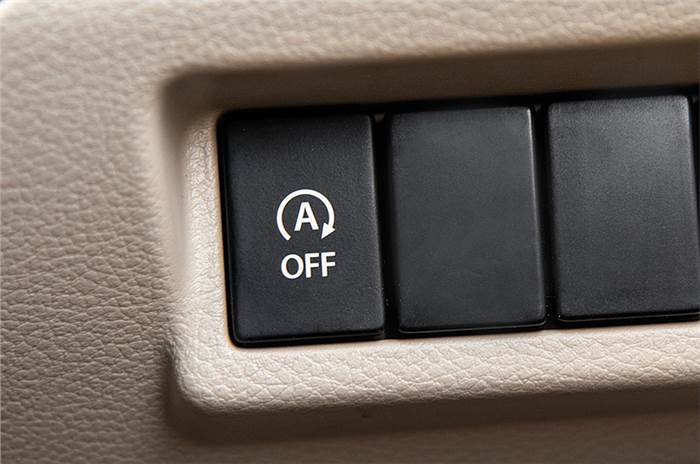2019 Maruti Suzuki Ertiga review, road test
This second generation is also a versatile and a value-for-money package. But how much better is it than the previous Ertiga?
Published on Feb 27, 2019 06:00:00 AM
1,83,045 Views
Follow us on


Artificial wood trim, Audi Q7-like air vents and a beige theme lend an upmarket look to the interiors.

Loading lip is low, the boot is well-shaped and more usable than before.
The new petrol engine is very similar in character to the older 1,373cc unit that it replaces. Throttle responses are sharp, and the gear ratios are so well judged that the motor builds speed cleanly from lower down the rev range. The ease with which the Ertiga petrol pulls on an incline from 20kph in third gear with a full load of passengers is quite impressive. As long as you aren’t in a hurry, the motor does the job smoothly and silently. Dab the accelerator by 10 or 20 percent, or even under high load, an animation on the MID screen shows the battery providing some additional power to the petrol engine – this is done to improve its responsiveness. While this electric boost from the secondary Lithium-ion battery isn’t pronounced, a crisper throttle response surely is. Performance in the mid-range is flat and lacklustre, although beyond 4,000rpm, there’s a small bump in performance that remains strong until the redline. With the needle swinging to the far side of the tachometer, the engine is quite vocal, which is a contrast to its otherwise silent and refined character. The added 13hp and 8Nm of torque result in superior acceleration timings. 0-100kph is dispatched 1.46sec quicker than the older 1.4-litre petrol, and even within gears, the new 1.5-litre is quicker from 20-80kph and 40-100kph in third and fourth gear by 1.14sec and 1sec, respectively.

The petrol-automatic uses a 4-speed torque converter, with the first three gears being driving gears and the fourth being an overdrive gear. It is very smooth, the shift-logic is quite sorted and, for the most part, it does the job just fine. It’ll also shift to the highest gear at the earliest to aid fuel economy. Be gentle on the accelerator and it won’t downshift easily, and will try and build speed in the existing gear. Ask for more power though, and it’ll drop down a gear (or two) to get a move on, but with an increase in revs (from as early as 3,000rpm), the engine gets rather louder and louder as you pile on the revs. While driving in a hurry, there’s an ‘overdrive off’ function that ensures the gearbox will remain only in the first three gears, thus keeping the engine on the boil. There’s no manual mode but there’s a Low mode that locks the lowest possible gear, which is useful for uphill sections of road and/or to control the engine speed while going downhill, and also gives drivers the option to remain in second gear. Also, because the gear lever gate is straight, it’s very easy to slot into second gear or even ‘L’ rather than ‘D’ accidentally (especially while parking), and this requires some attention, while starting off from a standstill.

The Fiat-sourced 1.3-litre diesel engine remains unchanged, on paper at least. Get behind the wheel, however, and it feels a bit easier to drive and lighter on its feet compared to before. Turbo lag below 2,000rpm isn’t as significant and even when the boost comes in, it does so in a more linear manner. The meat of the powerband remains between 2,000 and 3,500 rpm, although the older car felt stronger until 4,000rpm before the power began to taper. The diesel is still an able highway cruiser, and as long as you’re driving within the powerband, overtaking feels effortless. Fall below 2,000rpm though and it still warrants a downshift to make rapid progress or make a quick overtake, and bigger speed-breakers still need to be taken in first gear only. While acceleration timings remain near-identical to the outgoing car, 40-100kph in fourth is now a significant 1.3sec slower, although it’s interesting to note that the fourth gear ratio is identical to the older car. What really let’s this motor down, however, is the hoarse engine note at idle. The engine clatter smoothens out once on the move, so when driving around at city or cruising speeds it feels fine, spin it harder, though, and the gravelly note gets louder and sounds unrefined as the revs build.
| Maruti Suzuki Ertiga Price, Mileage, Specifications, Features and Variants | |
|---|---|
| Brand | Maruti Suzuki |
| Model Name | Ertiga |
| Maruti Suzuki Ertiga Price | ₹ 9.84 - 15.20 lakh |
| Maruti Suzuki Ertiga Range/Mileage | Petrol : 20.3 - 20.51kpl | CNG : 26.11km/kg |
| Maruti Suzuki Ertiga Specifications | MUV | 5 doors | 7 seats View All Specs |
| Maruti Suzuki Ertiga Features | Halogen headlight | 7-inch Touchscreen display | 2 airbags View All Features |
| Maruti Suzuki Ertiga Variants | 1.5 petrol LXi MT | 1.5 petrol VXi MT | 1.5 CNG VXi MT View All Variants |
The petrol’s clutch is lighter than the diesel’s and the 5-speed manual transmission mated to both the engines is slick-shifting with short and precise throws.
Copyright (c) Autocar India. All rights reserved.






Comments
Member Login
Personal Details
No comments yet. Be the first to comment.